War Baby.
 “Bobby was a War Baby. That’s why his ears stick out.”
“Bobby was a War Baby. That’s why his ears stick out.”
So said his Mum Dorothy many times over her lifetime with Bobby. She rarely mentioned the war at all otherwise. Nor did Sid. His Dad.
This soul searching all started with an interesting post on Sutton and Cheam History Group. Bobby always intended to write it up as a very interesting but short story. Then promptly lost it. There are a number of stories in the pending tray like that. It resurfaced on the History Group last week and he was determined this time to feature it.
The title of this story would have been Sutton and Cheam WWll Bomb Map. Now it is ‘War Baby’. As the years went by, the term was treated with a little humour. Culminating in the badge you see in the picture. He ran a little party for his Mum to celebrate her 90th Birthday. Andrew made him the badge especially for the party. Dorothy didn’t see the funny side at all.
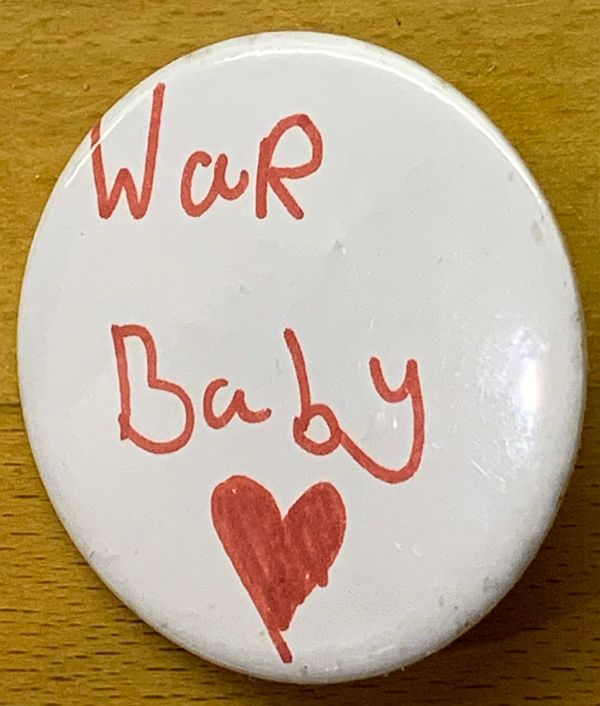
War Baby.
When we look at the bomb map below, you will see that there were two distinct periods when bombs fell on Sutton and Cheam. 1940 and 1944. We mentioned 1940 in Alf Garnett and how difficult it must have been for Sid cycling to and from work. We didn’t speak about 1944, because Bobby always assumed that since his birth was at the end of the war it was less eventful. Yes – Dorothy mentioned Doodle Bugs once or twice. But he doesn’t remember Sid talking about it at all.
Looking back, it seems highly likely that their hyperactive young son just wasn’t interested in the war, but rather the steam engines at Raynes Park. The airliners flying over on final approach to Heathrow. Playing football in the street, before cars came long. Riding a beaten up scrambler bike, with knobbly tyres, through the woods nearby. Dorothy even said to him years later that she didn’t think he was interested in family history either. The truth was that the present was so exciting that there was no room for the past. At ten years old, the war was a long time ago.
Sutton and Cheam were never targeted to bomb. They had no strategic value. But they were under the Luftwaffe’s flightpath to London. If a bomber encountered problems and turned back, it just jettisoned its bombs to make a quick getaway. Sometimes on Sutton and Cheam. Bearing in mind the bomb map is restricted to the borough boundary of Sutton and Cheam, there must have been similar concentrations in neighbouring boroughs on the way to London.
1944 was totally different. Far from being the last dregs of a long war, it saw the most frightening development of all. The Vergeltungswaffen. The ‘Retaliation Weapons’ or ‘Reprisal Weapons’. Germany was clearly on the back foot in the war and developed these highly sophisticated weapons to attack mainly Britain but also Belgium. Their main targets were London, Antwerp and Liege.
The V1
There were three V weapons. The first, the V1, was a cruise missile in effect. Launched from ramped launch sites in Northern France, they literally were a flying bomb. Propelled by a pulse jet engine, that made a very distinctive throbbing sound. The plan was simple. Aim it. Launch it towards its intended target. Calculate the fuel needed that would run out over the target and the bomb would plunge to earth.
Prompted by the Allied Normandy landings, the first V1 attack was carried out on London on 13 June 1944. Casualties were high. By late August, one and a half million people had left London. Gradually as counter measures against them became more effective people, started to return. Those measures being shot down from the ground. By chasing fighter aircraft. Even by brave pilots flying alongside wingtip to wingtip to tip them over before they reached London.
Imagine flying alongside a bomb trying to flick your wing against a bomb’s wing. But the best counter measure was destroying the launch sites by bombing and the advancement of the Allied troops.
They were terror weapons, whose sole purpose was to scare the living daylights out of the British people. They were revenge for what had happened when the fight was taken back to Germany. It’s a sobering thought, when we now know that Germany was developing an Atomic bomb. Bobby does remember his Mum talking about the “Doodlebugs”. How terrifying it was to hear that distinctive sound and how much worse when it cut out. Followed by eerie silence and an enormous explosion.
A total of 9,251 V1s were fired at Britain. Mostly at London. Many flying over Sutton and Cheam. 2,515 reached the city, killing 6,184 civilians and injuring 17,981. Croydon in particular, just a few miles from Sutton, was hit 142 times.
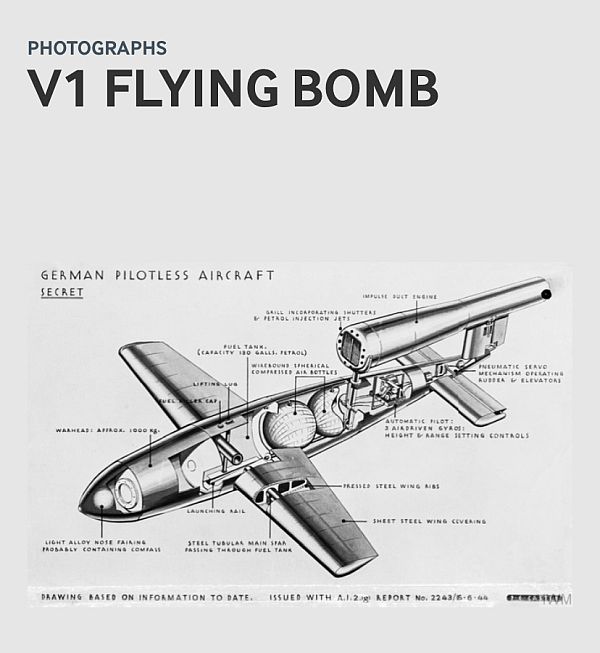
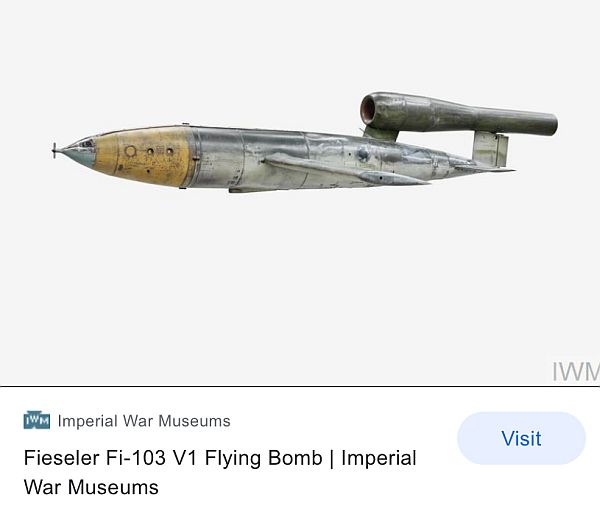


Then came the V2
An Intercontinental missile, launched from the Hague in September 1944, it took just 5 minutes to go up and come down on London. Unlike the V1, no one heard it coming, The V2 offensive continued until March 1945. 1,152 were fired at Britain. Mostly at London. Killing an estimated 2,754 people and injuring 6,523. The damage to property was massive, with an estimated 20,000 houses alone being damaged each day.
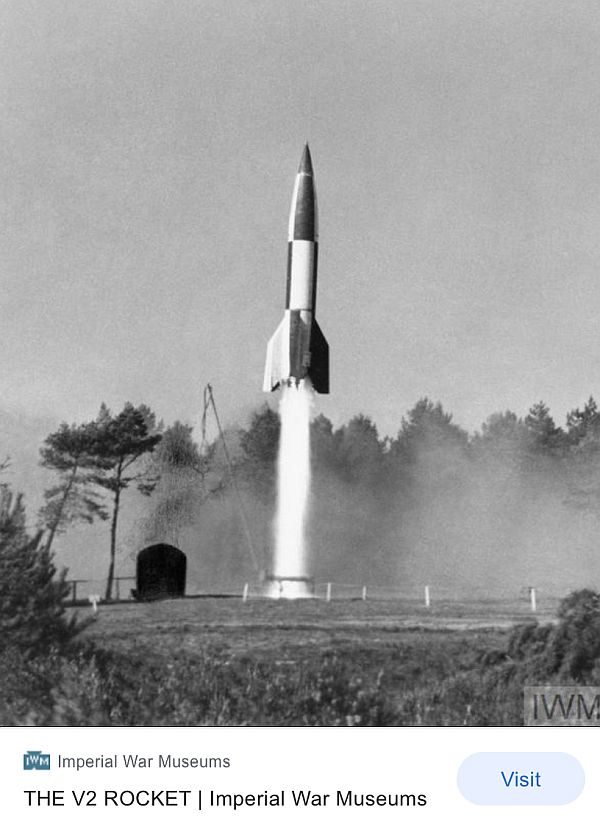
The V3
The V3 was a giant cannon that was never used on Britain due to the launch sites being overrun by the Allies.
The following is the shocking truth revealed later in the war and now archived at the Imperial War Museum.
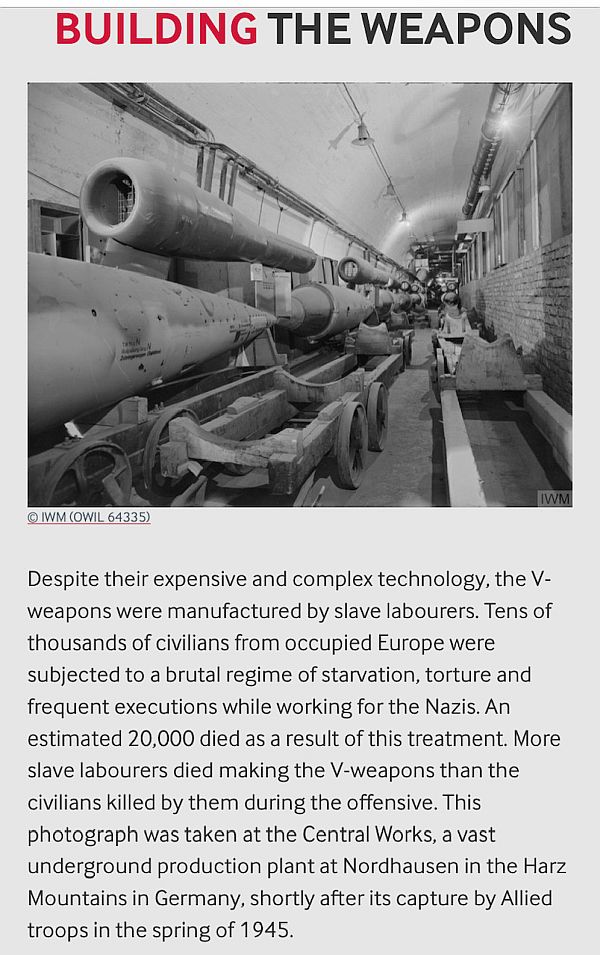
So now “welcome” to the WWII bomb map of Sutton and Cheam.
On a touch screen, use two fingers to expand it. We have taken a few pictures to reveal what happened to Brocks Drive.
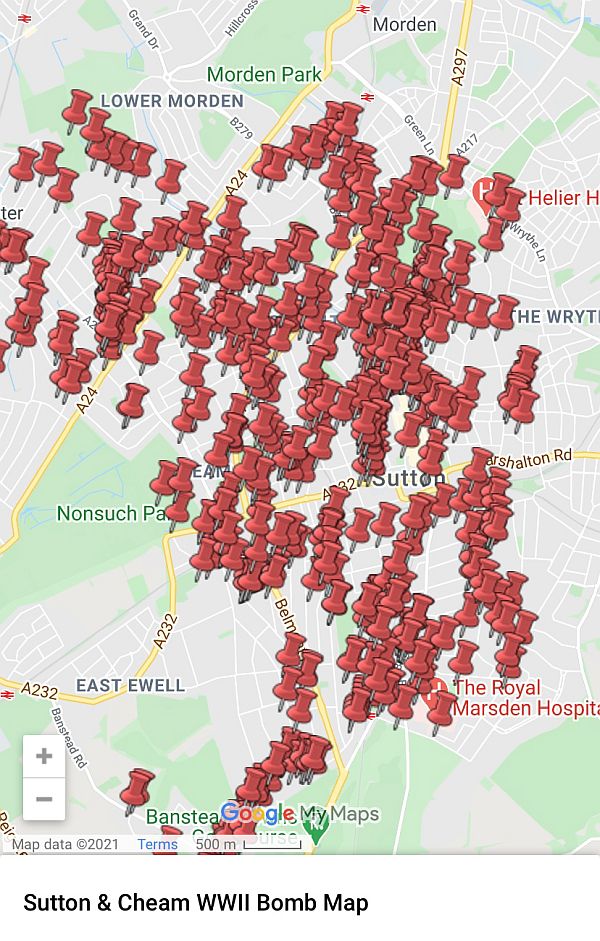
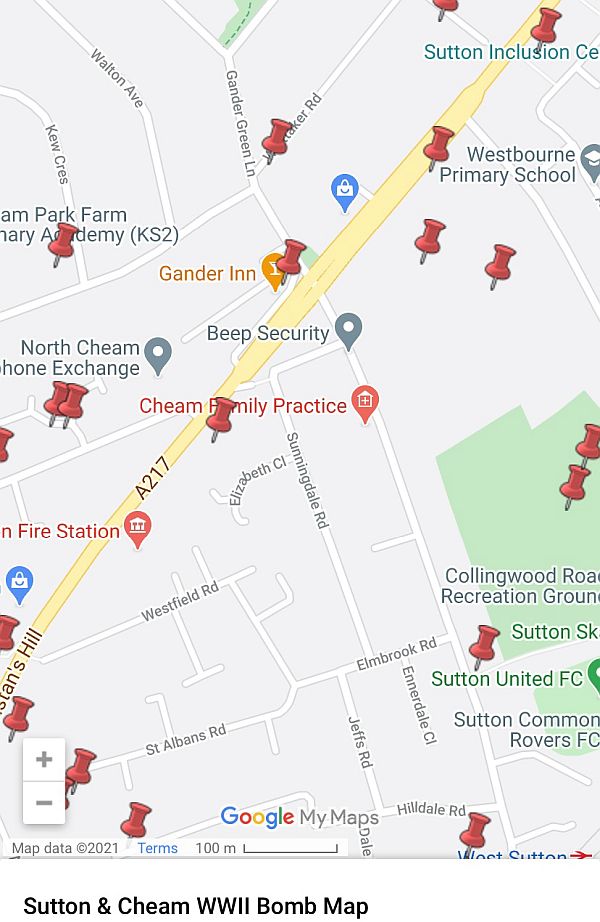
Notice Sutton United Football Club.
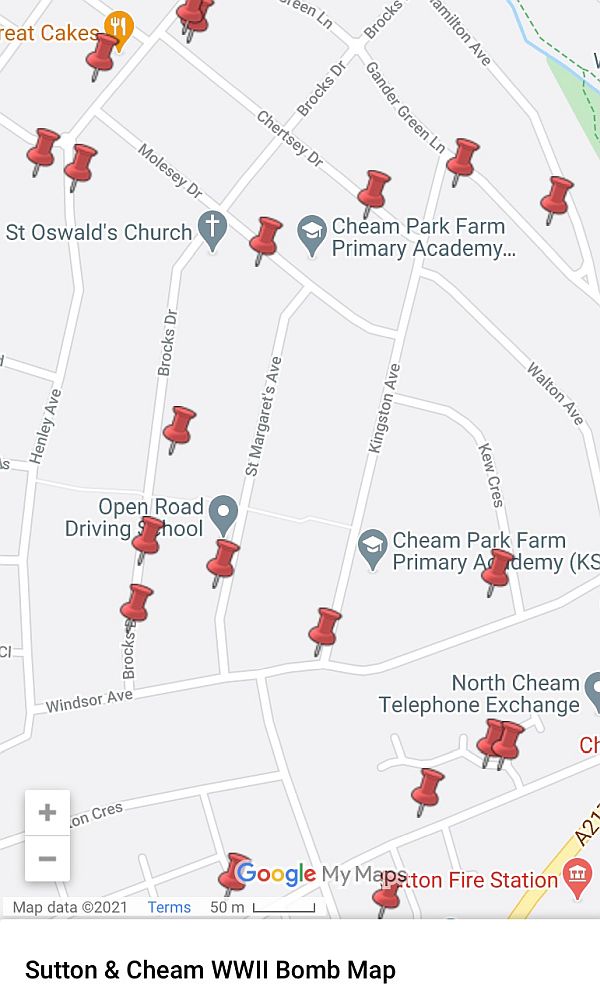
Notice three bombs in Brocks Drive.
1940. St Oswald’s Church, where Bobby married in 1966. Cheam Park Farm Primary. Originally the Infants School. His first school in 1949. Cheam Park Farm Primary Academy. Then just Primary. His second school and where the shelters were in the playing fields. Notice how many roads are named after towns on the Thames. Apart from Brocks Drive named after the firework factory.
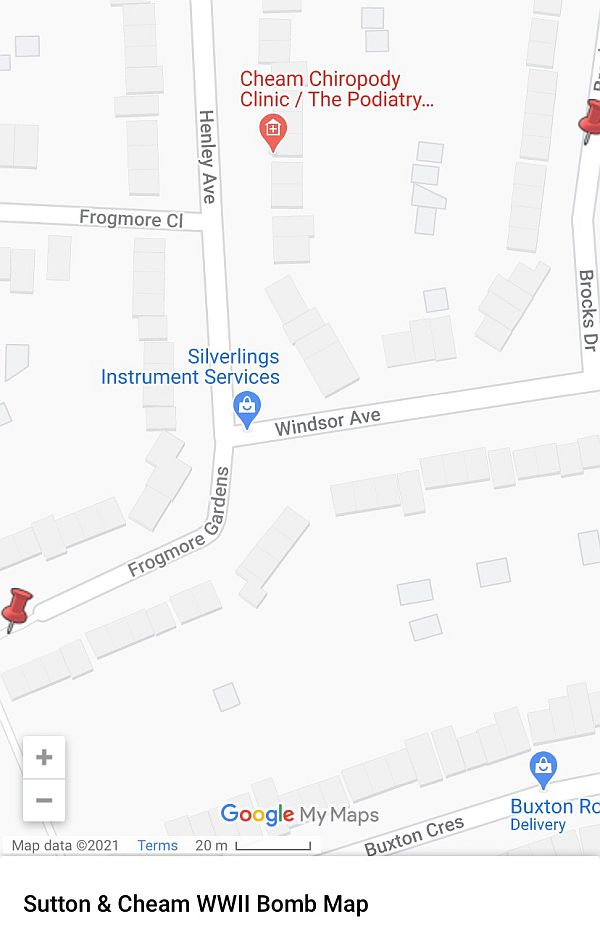
Frogmore Gardens. An errant flying bomb in 1944 that wiped out a family. See how close it was to Brocks Drive the night it brought the ceiling down on Bobby’s brother (see below).
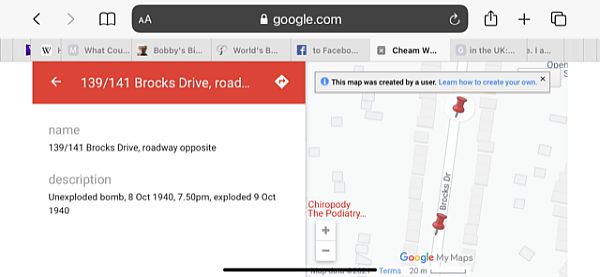
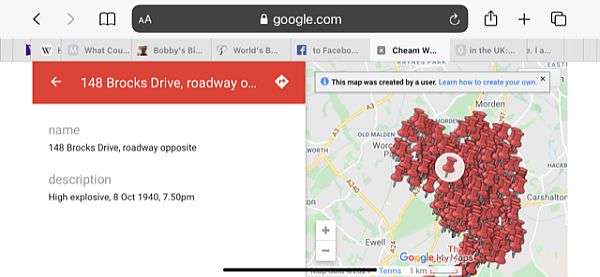
See how close they were to 138 Brocks Drive.
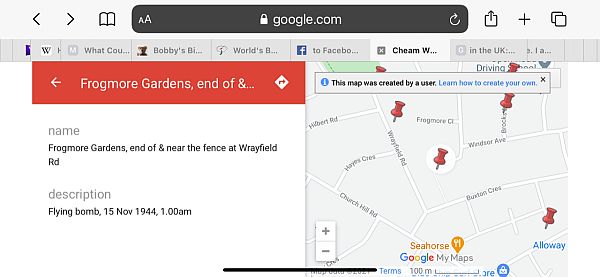
Flying bomb 1944. See how close it is to Brocks Drive the night it brought the ceiling down on Tony (see below) and killed an entire family.
Bobby’s Brother Tony
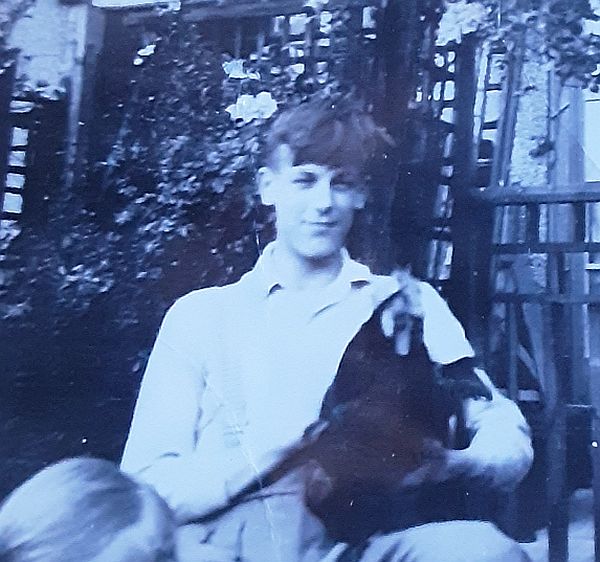
Tony 1940… with a chicken. Many families had chickens. Some ducks during the war and in the early post war years. Bobby remembers the distinctive smell of a chicken coop.
Tony was eighteen years older than Bobby. What he thought of a baby being born in the war in those circumstances, who can tell? Their Mum told Bobby that Tony was fascinated watching the doodlebugs fly over. But now we have something remarkable to share. Tony wrote a piece for a grandchild school project in his advanced years describing what it was like living in Brocks Drive during the war. His daughter Elizabeth, our resident genealogist, still has it.
And here is an extract from it:
Tony joined the navy in 1945 and had lived at 138 Brocks Drive throughout the war. He describes the evening in 1940 when a bomb fell in front of their neighbour’s house five doors away making a great hole in the road and damaging the house. Sid was on his way home from work but had heard the bomb and was worried about his family. After he arrived home, everyone was told by the air raid wardens to go to the school shelters which were not far away as there was a second unexploded bomb just across the road. Someone had tripped over a small hole it had made. Several people took their tea making things with them.
A few hours later, one neighbour was standing at the top of the road, held back by the wardens and with a tea basket on the ground, when the bomb went off. He was upset because his tea mugs were broken. All houses were left standing but the four closest to the second bomb had to wait years for repair. 138 was alright. The next morning, the drama continued when the wardens found another hole down the road bigger than the last one. Tony (14 don’t forget) went with his mates to investigate. They were told to clear off as it might explode. The army came along and dug out a very large bomb and took it away in a truck.
The flying bombs arrived in 1944, several near enough to Brocks Drive to shake the house a little. By this time they had an indoor shelter and they were often in there. One night the family were in their beds when one flying bomb fell after the main attack. Hence they were not in the shelter. Tony didn’t hear anything but woke up with the bedroom ceiling on top of him!!. He got up uninjured and went with a mate to the bomb site wearing his dad’s fire watcher helmet. They wanted to check on another friend. His house was damaged but the friend was safe.
Elizabeth is unsure if sister Wendy was there during these bombing raids as she spent much of the war evacuated to Leeds.
Now go back to the bomb map pictures and you will see that Tony’s recollections tie up exactly with the map. The map doesn’t mention casualties, but Bobby’s mum often told him that the flying bomb (that brought the ceiling down) killed an entire family in Frogmore Gardens.
Conclusion
Bobby WAS a war baby. His first few months of life were spent regularly in an indoor Morrison shelter. More or less sleeping with his family in a metal box.

Morrison shelter. Placed in the front room of 138 Brocks Drive. One side was hinged to allow you to crawl in.
He lived through just a few months at the end of the war, when Germany had unleashed terrifying weapons on Britain. Many on the civilian population. It’s hardly surprising that Dorothy didn’t see the funny side. Here she was, a mother of Tony now eighteen years old. Soon to join the navy. Wendy ten years old and evacuated to Leeds and didn’t like it there. And now, at nearly 45 years old, the mother of a new baby with whom she crawled into a Morrison shelter every night with Sid and Tony until the all clear was sounded. Waiting for the next Doodlebug, hoping the engine wouldn’t cut out overhead.
It was all indiscriminate. On the 3 August 1944, the sleepy little hamlet of Abinger Common was getting ready for morning service at St James Church. Some 25 miles from central London. A flying bomb hit it and nearly destroyed it. Luckily no one was in it. The church was restored after the war, but took many years to do so.
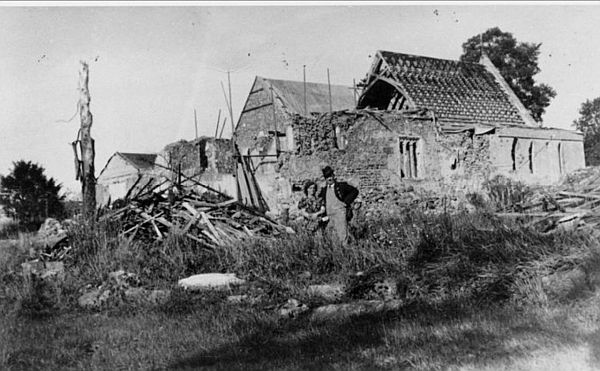
St James Church Abinger Common. 3 August 1944.
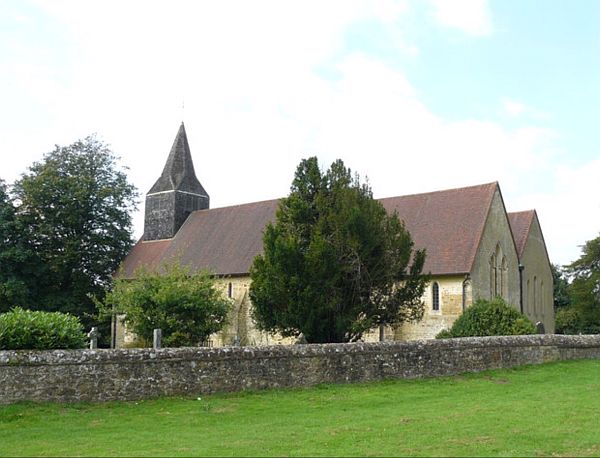
St James Church Abinger Common today.
What Bobby does vividly remember is what Sid thought of Germany. Can you blame him? Bobby was just a new born baby, blissfully unaware of what it must have been like. Later, at Cheam Park Farm Juniors, playing cowboys and Indians on top of those grass mound shelters at Cheam Park Farm School that were still there ten years later.
It’s undoubtedly true that Bobby’s generation will always look back in retrospect with different feeling about the war than younger generations. Bobby has German friends. Rolls-Royce is owned by BMW. And he has been to Germany on holiday. Something unimaginable to Sid and Dorothy, who had also lived through WW1. Some still consider that Brexit is partly a result of an older generation’s prejudices.
Wernher von Braun, who designed the V2 later, came to be fêted as a hero of the space age. All the Allies wanted him. The Americans got him. There is a direct line between the V2 rocket, built by slave labourers and launched from Nazi occupied Europe, to the first American in space. Would America have landed a man on the moon without Wernher von Braun? Who knows?
But the ‘war baby’ lived through momentous times, culminating in him talking to Sid the day (or night) man landed on the moon. When people ask Bobby about his Dad, he always says he lived long enough to witness that and died a few months later. On Christmas Day.
Germany today
We decided to start Mindfully Bertie in May 2016 in Spitalfields. Three days later, we embarked on a train journey around Europe. Including a number of places in Germany. Here is a little recollection:

The BOB Train. Munich to Schliersee. A popular lake resort.
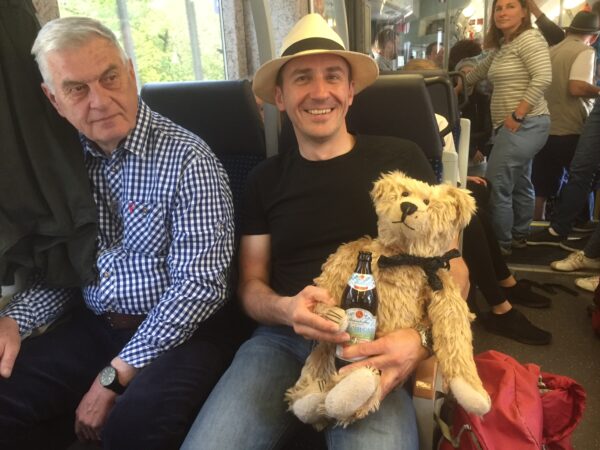
Gerhard and friends on the BOB train with tons of beer. He loved English football.
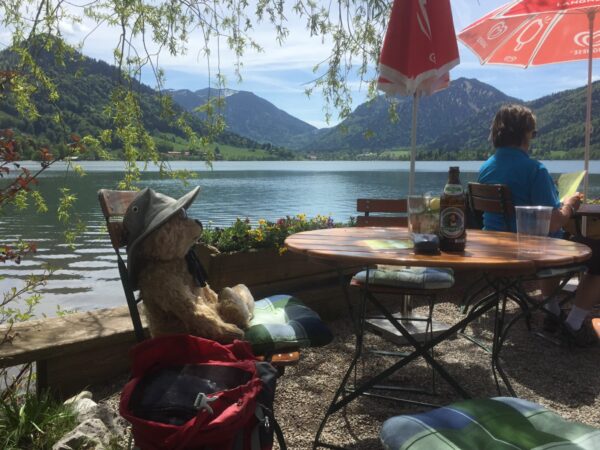
Lake Schliersee.

Beautiful Schliersee. On the Austrian border.
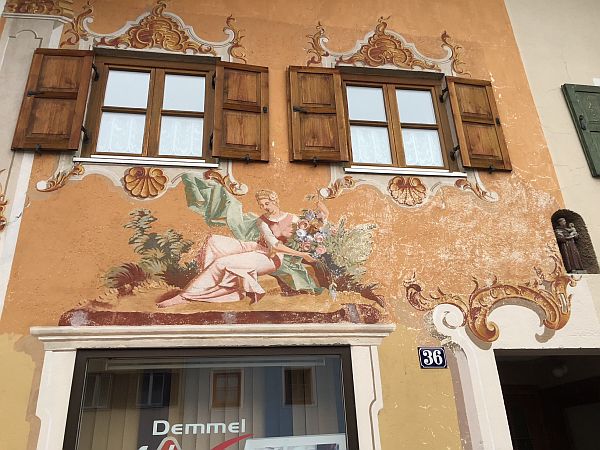
Mittenwald, Bavaria.
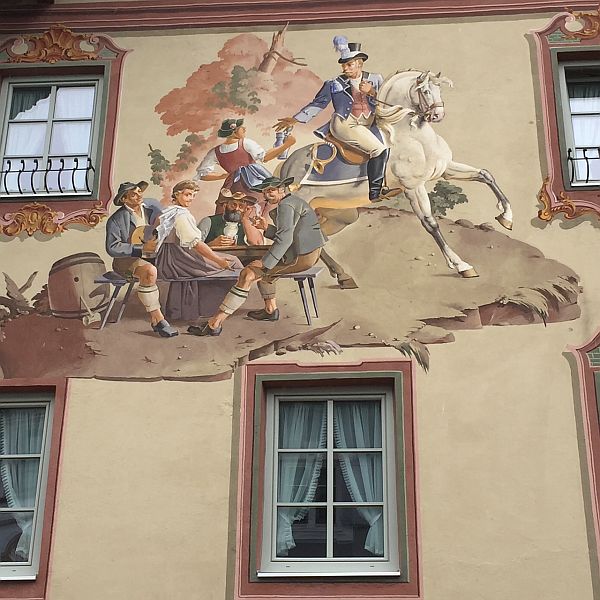
Mittenwald, Bavaria.
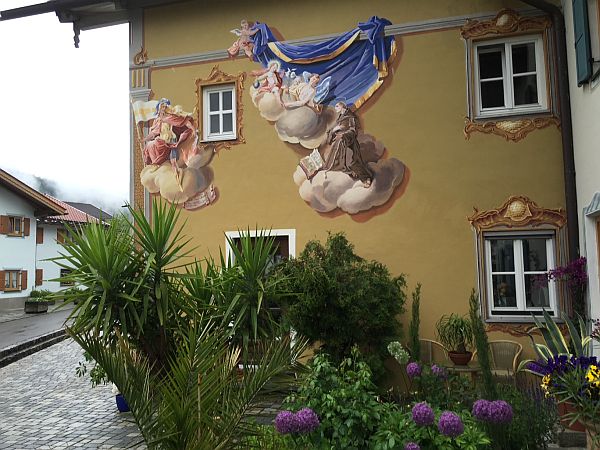
Mittenwald, Bavaria.
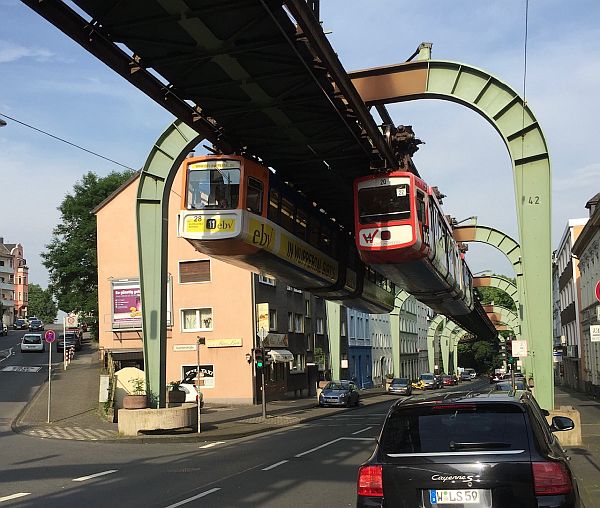
Wuppertal Schwebebahn. Probably our favourite railway. The world famous upside down railway.
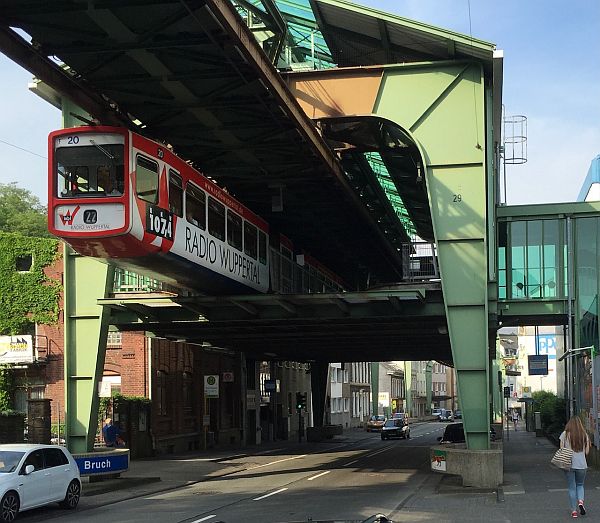
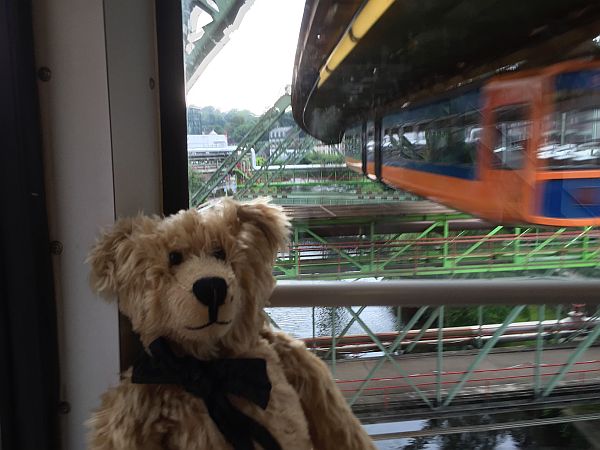
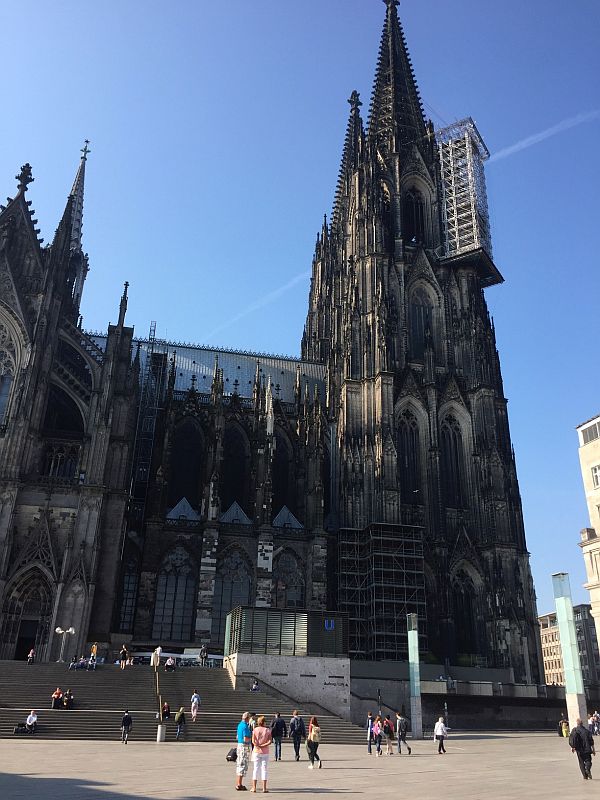
Cologne’s magnificent cathedral.
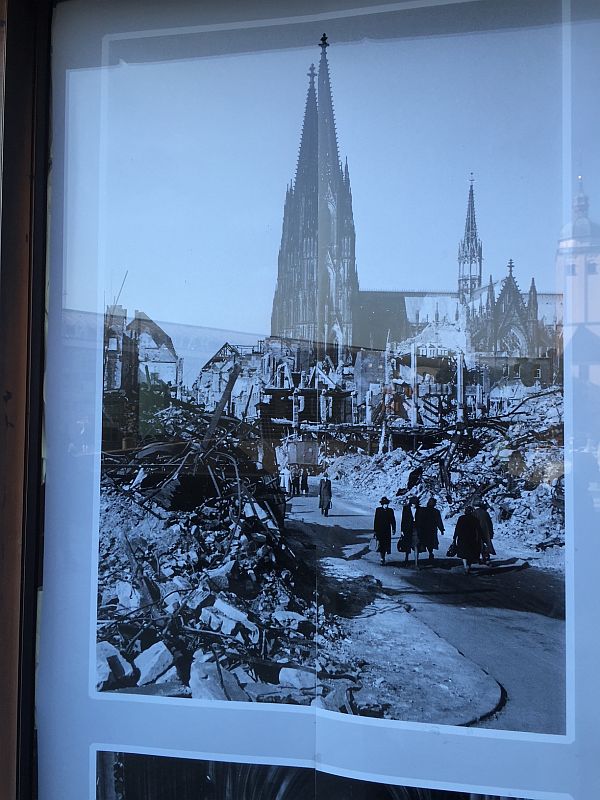
Like St Paul’s, the cathedral survived the war and the bombing, which the rest of Cologne did not.

Cologne Cathedral.
Lighting a Candle for Diddley and Don Dawes
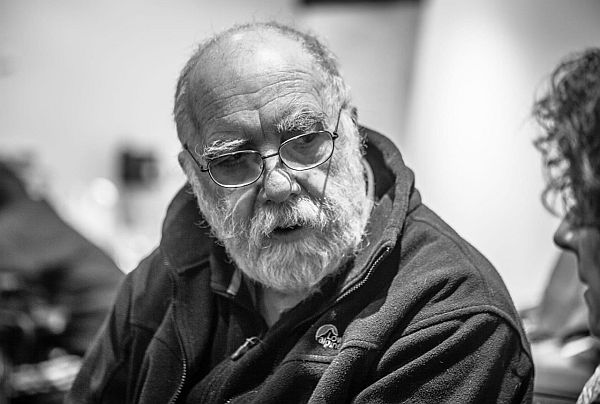
Bobby: “Don and I were colleagues at the Legal and General for decades. In the early eighties, we became involved in a campaign to ensure that the swimming facilities then enjoyed at Kingswood would be replicated in the new proposed office development. The result was the magnificent new pool opened in 1987.
I was made redundant in 1992 and lost contact with many old colleagues. Years later, through the wonders of social media, I regained contact with Don and forged a friendship over the airwaves based on our shared love of life: planes, trains, birds and words.
I learned so much about his beloved Ireland and looked forward to his almost daily posts. The friendship was based on the foundations of years at the Legal and General. We learned what our respective fathers did in the war. I shall miss you Don and your words of wisdom.”
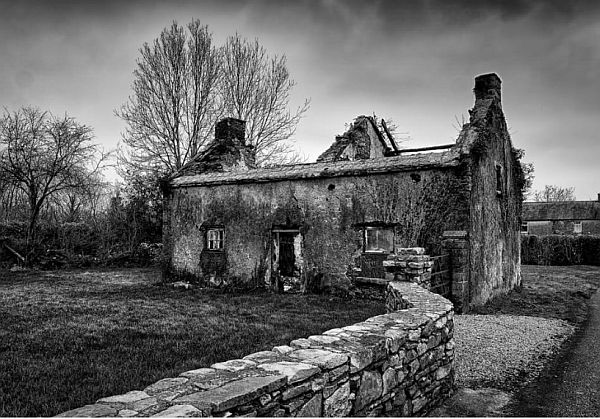
Don loved photography and this is the last picture ever posted by him a few days before he died. In Ireland. Of course.
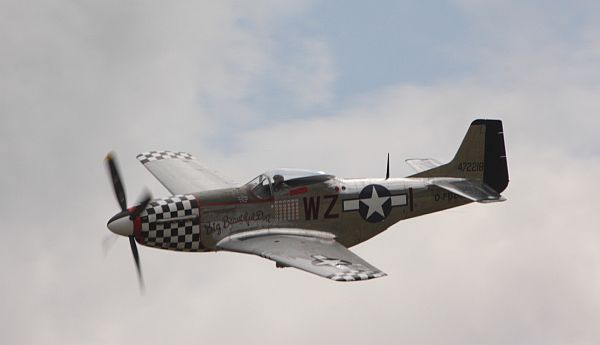
This is a picture of Bobby’s, but shows the plane that Don and he agreed was their favourite. The P51 Mustang.
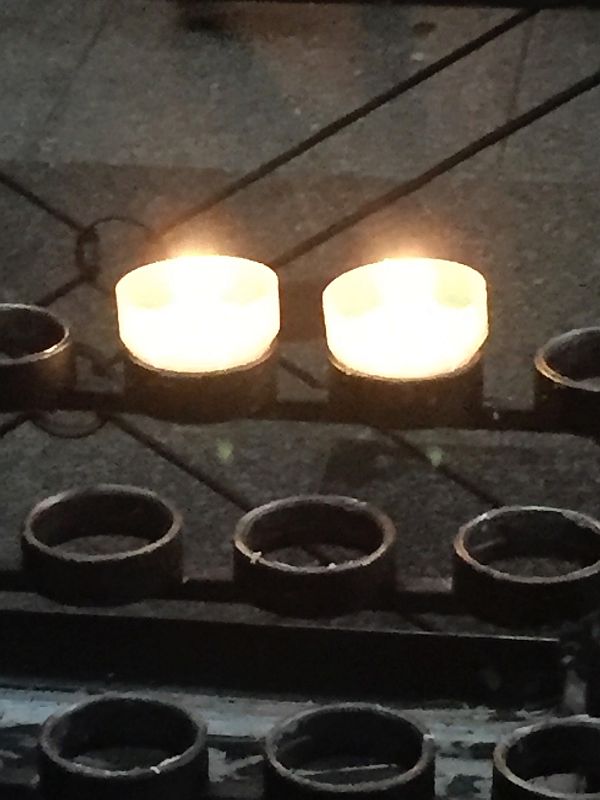
These candles were lit in Cologne Cathedral in 2016.
—————




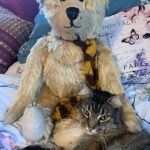


Leave a Reply